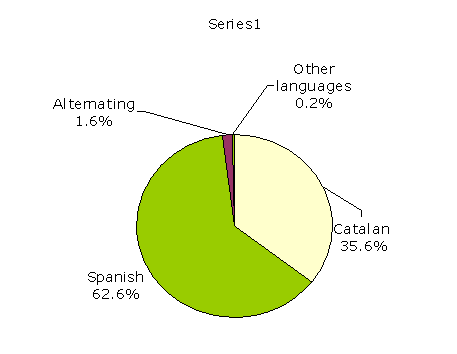
Factors
explaining informal linguistic usage among Catalan schoolchildren:
initial language, social networks, competence and vehicular language
for teaching, by Mireia Galindo i F. Xavier Vila |
||||
| CONTINUA |
Graph 1. Language of children's speaking
turns
Source: Vila and Galindo body of data Table 5. Language of speaking turns in
languages other than Catalan and Spanish by children
Font: corpus Vila, Vial i Galindo Concerning the scarce presence of the languages of new immigrants, it must be borne in mind that the research was carried out between 1996 and 1998, years when the percentage of foreign pupils in primary education was around 2%, a percentage far removed from the 12% of the 2006-2007 school year (www.gencat.cat/education). In fact, the sample of schools did not include centres with a high proportion of newcomer pupils. Despite this, 2.4% of children in the sample declared that they used a language other than Catalan or Spanish with at least one member of their nuclear family. This percentage is much smaller in the social network questionnaires: only 1.2% declared that they used languages other than Spanish or Catalan in their everyday relationships outside the home. In other words, outside the home, the foreign-language-speaking children in our study adopted the environment's normal language for relationships. It is more than probable that research such as that described here carried out today would record a greater presence of languages such as Berber, Arabic, Chinese or Romanian. In this sense, it would be quite daring to extrapolate from the data presented here. However, it must be taken into account that the interpersonal use of immigrant languages is in no way proportional to the presence of foreign language speakers in the classroom. Research such as that by Gomàriz (2008a, 2008b) shows that, even in contexts in schools where foreign language speakers exceeded 10% and were almost all of the same origin (in this case Berber), the use of these foreign languages falls back rapidly, not only in relations with classmates but even in relations with brothers and sisters, in favour of the predominant environmental language – in this case Catalan. Meanwhile, confusion between foreign, immigrant or newcomer pupils and foreign-language-speaking pupils must be avoided: to begin with, a good proportion of recently incorporated pupils have Spanish as their initial or habitual language. For example, during the 2006-2007 school year, 43.1% of pupils with non-Spanish passports registered at schools in Catalonia were from Central or South America. Secondly, although a substantial percentage of immigrants do not pass on their languages to their children, in Catalonia there is a growing percentage of children born in the country who have foreign initial languages (Vila 2006). Finally, it is quite probable that a good proportion of foreign language speaking children educated in Catalonia are adopting Spanish as their language for social inter-relation, but it must be recognised that we have very little data to be able to state this with any certainty. In fact, then, everything leads to the conclusion that, in relative terms, the arrival of new immigrants must have increased the presence of Spanish in playgrounds, although it would be bold to state it categorically. In any case, here we will be analysing data from the School and Usage study.
|
||||||||||||||||||||
